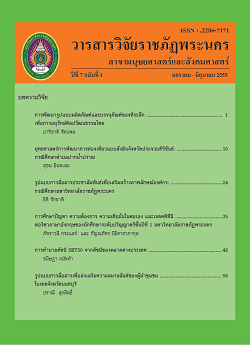รูปแบบการสื่อสารเพื่อส่งเสริมความสมานฉันท์ของผู้นำชุมชน ในเขตจังหวัดนนทบุรี
Main Article Content
Abstract
การวิจัยครั้งนี้มีวัตถุประสงค์เพื่อ 1) ศึกษาสภาพและปัญหาการสื่อสารของผู้นำชุมชนในเขตจังหวัด นนทบุรี 2) ศึกษากลยุทธ์การสื่อสารเพื่อสร้างความเข้าใจอันดีแก่ชุมชนตามความคิดเห็นของผู้นำชุมชน 3) สังเคราะห์และพัฒนารูปแบบการสื่อสารเพื่อเป็นต้นแบบ (Model) ของการสื่อสารเพื่อส่งเสริมความ สมานฉันท์ รายงานวิจัยนี้ใช้ระเบียบวิธีวิจัยเชิงปริมาณและการวิจัยเชิงคุณภาพ ประชากรที่ใช้ในการวิจัยครั้งนี้ คือผู้นำชุมชนในจังหวัดนนทบุรี 6 อำเภอ ประกอบด้วย นายกเทศมนตรี นายกองค์การบริหารส่วนตำบล กำนันผู้ใหญ่บ้าน และผู้นำความคิดหรือตัวแทนชาวบ้านที่เป็นที่ยอมรับ และสมาชิกจากชุมชนต่างๆ ในจังหวัด นนทบุรี รวม 942 คน การวิเคราะห์ข้อมูลเชิงปริมาณ ใช้สถิติบรรยาย ได้แก่ค่าสถิติร้อยละ ค่าเฉลี่ยเลขคณิต ส่วนเบี่ยงเบนมาตรฐาน และใช้สถิติเชิงอนุมาน ได้แก่ การวิเคราะห์สถิติสหสัมพันธ์เพียร์สัน การเก็บรวบรวม ข้อมูลได้จากการสัมภาษณ์เจาะลึก การสนทนากลุ่ม และการสังเกต นำมาประมวลผลข้อมูลและจัดระบบ ข้อมูล แล้ววิเคราะห์ตามกรอบวิจัย โดยเทคนิคการวิเคราะห์เนื้อหาแบบสร้างข้อสรุป
ผลการวิจัยพบว่า :
สภาพและปัญหาการสื่อสารของผู้นำชุมชน มีการเปิดรับข่าวสารจากสื่อมวลชน และใช้สื่อเฉพาะกิจ ในชุมชน ได้แก่ หอกระจายข่าว/เสียงตามสาย สื่อบุคคลในท้องถิ่น ใบปลิว จดหมายข่าว การปิดประกาศตาม บอร์ดสาธารณะ และการจัดกิจกรรมต่างๆ ในชุมชนมีความถี่ในการเปิดรับอยู่ในระดับปานกลาง ผลของ การรับรู้ข่าวสารทำให้ผู้นำมีความสนใจ มีทัศนคติและการแสดงออกทางการเมืองอยู่ในระดับมาก และมี ความรู้ความเข้าใจอยู่ในระดับปานกลาง ส่วนปัญหาการสื่อสารของผู้นำโดยรวมอยู่ในระดับปานกลาง คือ ผู้นำมักใช้สื่อของทางราชการมาชี้แจงกับประชาชน และมีความเห็นว่า ข่าวสารทางการเมืองมีความซับซ้อน ซ่อนเงื่อน ยากที่จะทำความเข้าใจ ทั้งผู้นำและสมาชิกในชุมชนต่างติดตามการเสนอสารทางการเมืองของสื่อ/ กิจกรรมที่ตนชื่นชอบ ในขณะที่สมาชิกในชุมชนก็มีความเห็นสอดคล้องกับผู้นำชุมชน ผู้นำไม่ควรรับรู้ข้อมูล ข่าวสารอยู่คนเดียว ต้องกระจายข้อมูลให้สมาชิกในชุมชนรับทราบและรับฟังความคิดเห็นของสมาชิกในชุมชน ด้วยใจเป็นธรรม รวมทั้งมีการหาแนวทางแก้ปัญหาร่วมกัน
กลยุทธ์การสื่อสารเพื่อสร้างความเข้าใจอันดีแก่ชุมชนตามความคิดเห็นของผู้นำชุมชน พบว่า กลยุทธ์ ด้านผู้ส่งสาร ด้านเนื้อหาสาร ด้านสื่อ/ช่องทาง/วิธีการ และด้านผู้รับสาร มีความคิดเห็นอยู่ในระดับมาก กล่าวคือ ผู้ส่งสาร(ผู้นำ) และผู้รับสาร ต้องเข้าใจบทบาทตัวเอง เป็นกลาง ให้ความสำคัญกับการมีส่วนร่วม วิเคราะห์ข่าวสารก่อนจะสื่อสาร รู้เท่าทัน เป็นนักฟังที่ดี ส่วนสื่อต้องมีความเป็นกลาง เป็นธรรม เสนอสารที่ เป็นจริงและถูกต้อง ส่งเสริมคุณธรรมและจุดแข็งของชุมชนและประเทศ
การสังเคราะห์และพัฒนารูปแบบการสื่อสารเพื่อเป็นต้นแบบ (Model) ของการสื่อสารเพื่อส่งเสริม ความสมานฉันท์ โดยชุมชนต้องมีลักษณะร่วมกัน 6 ประการ คือ 1) ความมีส่วนร่วมของทุกคนในชุมชน 2) ความเชื่อมั่นในตัวผู้นำ 3) ความยุติธรรมในสังคม 4) การศึกษาของคนในชุมชน 5) เศรษฐกิจอยู่ในระดับ พอเพียง และ 6) การมีหลักธรรมเป็นเครื่องยึดเหนี่ยว ซึ่งนำมาบูรณาการกับรูปแบบการสื่อสารเพื่อส่งเสริม ความสมานฉันท์ สามารถสร้างเป็น “นนทบุรี โมเดล” (NONTHABURI Model)
Communicative Model for Promoting of Reconciliation among Community Leaders in Nonthaburi Province
The purposes of the research were to study conditions and problems about communication of community leaders in Nonthaburi province, to study strategies in communication among community leaders, and to synthesize and develop the communicative model for promoting reconciliation. Quantitative and qualitative methods were used. The samples were 942 people who were community leaders of 6 districts of Nonthaburi province i.e. the mayor, the president of local administrative organization, sub-district headmen, and village headmen, along with thinkers, local representatives, and members from various groups. The quantitative data were described by descriptive statistics, i.e., percentages, mean (), standard deviation (S.D.), and Pearson Correlation. The content analysis was performed to analyze the qualitative data obtained from in-depth interviews, focus group discussions, and observations.
The results were as follows:
Conditions and communication of the community leaders: They were open to any news and information in the various forms of mass media and local media, namely public speakers, personal media, leaflets, newsletters, billboards, and activities. The frequency in receiving news and messages was moderate. The news acquisition of the leaders helped facilitate interest in politics and political involvement at a high level and the understanding at a middle level. The problem of the leaders’ communication was at a middle level in overall. In particular, the leaders often delivered messages through official channels and opined that political news was complicated. The leaders and members followed political news and kept updated about their favorite activities. Meanwhile, community members had the same point of views as their leaders. As for the qualitative analysis, it suggested that the community leaders should not keep the news on their own but they should transmit it to the members. Besides, they should listen without bias, and invite public participation in problem solving.
Communication Strategies for understanding among members in the opinion of the community leaders: It showed that the sender, the message, the media/ the channel/the means, and receiver were at a high level. In other words, the sender and the receiver had to understand their roles, place an emphasis on public participation, analyze messages before transmission, achieve media literacy, and be good listeners. Meanwhile, the media had to stay neutral ensure fairness. The message had to be accurate, promote morality, and help strengthen the community and the country.
Synthesis and development of communicative model for promoting reconciliation: The community leaders had to have the 6 common characteristics, namely members’ participation, trust in leaders, social equality, education, sufficient economy, and morality. These characters were integrated into “Nonthaburi Model,” or a communicative model intended to promote reconciliation.
Article Details
Each publish articles were copyright by Phranakorn Rajabhat University
Any contents which appeared in each articles in the journal were authors personal opinion. It did not relate to Phranakorn Rajabhat University and other instructors in the university. Each authors would take responsibility on their articles. If there are any mistake, the authors will take responsibility themselves


